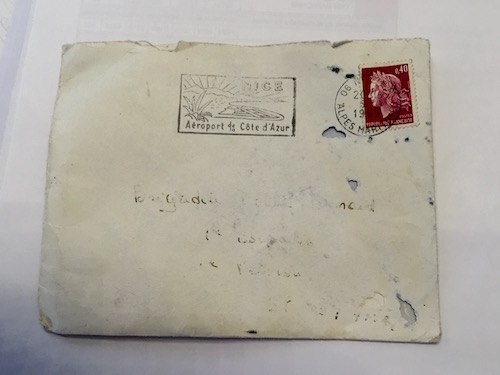I’ve been meaning to at least jot down some of the history of the house, or at least some of the facts and indeed, some of the fiction.
This is just a draft really, jotting down some of the things I’ve heard, so that I can put everything together in a timeline later on.
I’ll start with the first meeting with the lady mayoress, who seems to know quite a lot about the old house. Not because she is the mayoress, but because she has lived in the village for years, and stories are passed on I guess. Others wanting to offer details of the history are:
Madame Duchazeaubeneix (widow Doutre), the previous owner;
Madame Bringuier, the old lady who lives on the opposite side of the courtyard behind the house;
Her son, a former bodyguard for 3 French presidents, who lives just across the Place;
and finally Clément, an interesting old man who sits on his bench looking out over the Place de la République on sunny days.

Shaded red is the house and the garden and in blue are the owners around and about
It appears that the property was originally built in 1769, although my in-depth searches may prove otherwise. There’s no date on the front of my house, but above Madame B’s door there’s a date plaque of 1769.
The main house been divided up over the years – the main house (109/110) had a courtyard behind, some stabling, and an additional house (111) where Madame Bringuier now lives. There was also some extra land (678) and a large covered area close to the garden (108) that all made up the original house plan. Madame D told me that around the mid-19th century, the house owner was a wealthy vineyard owner, who during the times of the grape harvest employed many people who stayed on the property. More accurately, they lived in the house where Madame B lives now. When the owner died, he left the house and the several other bits I have described to a gentleman grape-harvester, who seems to be some tenuous descendant of Madame B. A bit later, I think around the end of the 19th century, the main house was also divided through the middle into approximately two equal parts. This can be seen on the ‘plan cadastral’, which is an up-to-date record of the land boundaries of every part of France.

Outlined in red is the house and land as it was built. Personally I think Parcelles 508, 509 and 677 were also part of it as it would give more uniformity to the layout. I haven’t checked, but maybe the two circles in 677 are wells for water?
Shaded in blue is the part ‘given to the grape-harvester in the mid 1800’s.
Some of the stories remain the same whoever tells them.
The clearest is the link between the lady who sold me the house, Madame Duchazeaubeneix, her mother Madame Doutre, and the lady owner before her everyone calls ‘The Countess’. This very well heeled spinster, a Madame Pagès, had a number of servants living in the house, and owned a beautiful horse-drawn carriage. This was undoubtedly before the age of the motor vehicle or I’m guessing she would have had one. By all accounts she was a devote church-goer and left the majority of her estate to the Church when she died. The house was left to Madame Doutre (her great great niece) and her husband. Madame Bringuier remembers her neighbour Madame Doutre very well – she tells me how she appeared to want to live the life of her benefactor M.Pagès, without the financial means. I don’t think they saw eye-to-eye on many occasions!
In 1997 Madame Doutre’s husband Roger died, so she lived alone in the house for 10 years before moving to an old peoples home. She finally passed away in 2010.
The mayor tells a story of the Countess having a male friend towards the end of her life, a man Clément my neighbour called ‘The Count’. He proudly recalls le Comte et la Comtesse.
Clément is 93 years old, and although he has only lived as a neighbour for the past 20 years, he was born in the village so knew them both personally.
The Count seemed a colorful character, a betting man, who won and lost fortunes playing the French card game Baccara, or Baccarat. He was a stuttering lawyer.
Before this period and back before 1900, I know no names or relationships of the owners, although another meeting with Madame le maire will bring to light a few more clues.
So the previous owners/occupiers so far are:
2016 – Harvey Lacey
June 2010 – June 2016 Madame Anne-Marie Duchazeaubeneix (DOUTRE), her brother Bernard (DOUTRE) and sister Marie-Odile Mounie (DOUTRE)
c1970 – 2011 Madame Suzette Joffres (DOUTRE) and her husband Roger
c1900 – c1970 Madame Pagès and her stuttering man friend
***
Yesterday, I found an old love letter well hidden in the attic space behind the support for some old shelving. Dated 1969 and sent from Nice, it was posted to a Brigadier ??, it tells of young love between a certain ‘J’ and her sweetheart ‘Bernard’.
On the reverse of this letter was marked her surname and address. J. Valladeau, 9bis rue Andrioli, Nice.The surname rang a bell, and when I checked on a copy of the house exchange documents, I noticed that in fact they were now man and wife, Bernard et Joëlle DOUTRE, married on 15 May 1970 and still living, and one of the owners of the house before me.
So the question arises, did they ever live as a family in the big house with their parents?

A meeting, a chat, and a glass of pastis with Madame Duchazeaubeneix, the teary-eyed previous owner may iron out some old rumours!
